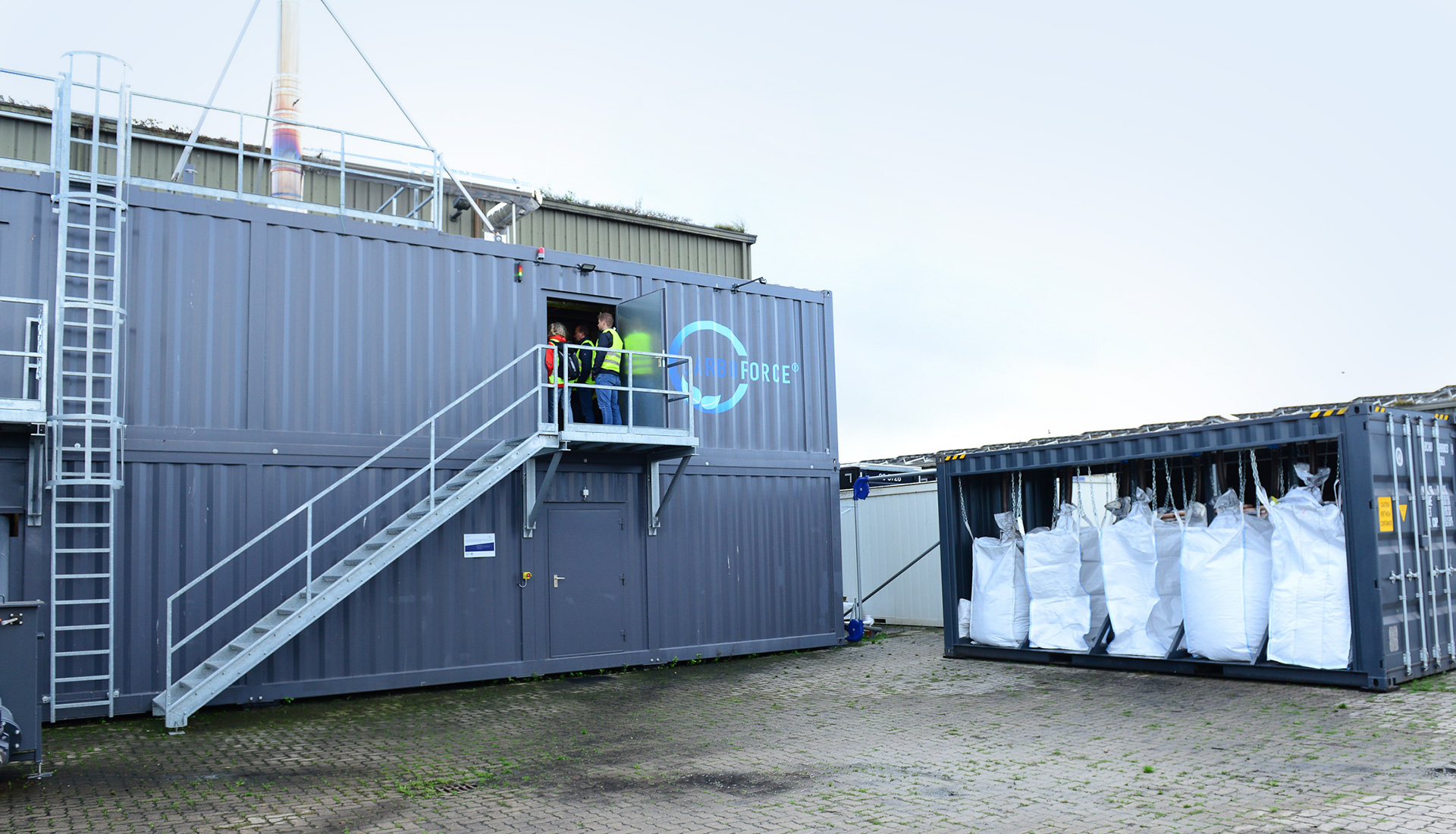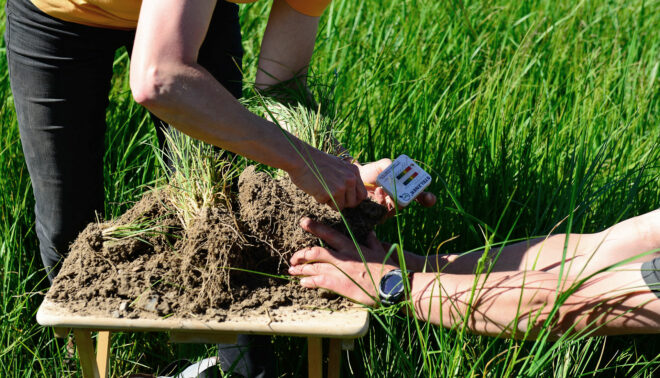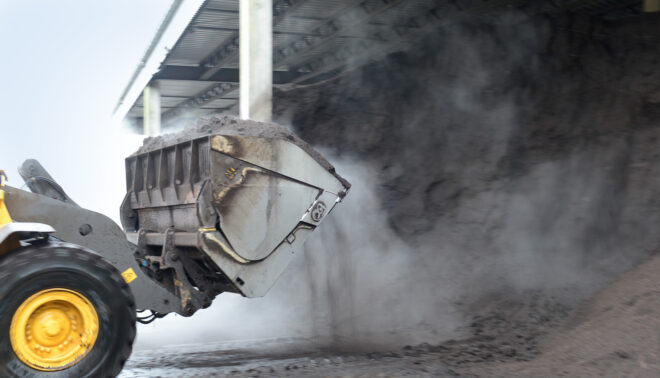Biochar is produced by the high temperature carbonisation of materials like wood and cellulose residues, turning them into finely divided carbon. It’s a prospect that is currently a source of great inspiration – including in agriculture. For example, this spring, Mathis Block, a milk producer from Schleswig-Holstein, started building a biochar production facility on his farm in Osterrade. “If not now, when,” says the 34-year-old about his bold investment of around €1m (£867,310), which he is making together with his brother Steffen.
Although the brothers also considered building a biogas plant, they decided against it in the end; instead, they wanted to try something new. And as it is with new things, many questions still remain unanswered. Where does the biomass material come from? Who will buy it or how can it be used on your own farmland? How is it processed? Further changes in the price of carbon credits will be another important aspect in determining whether the project will ultimately be a commercial success.

Mathis Block, Milk Producer
We want to feed the system with wood chips from the region.
Mathis Block
As a result of the Paris Climate Agreement and the EU’s target to decarbonise the entire economy by 2050, increasing revenues are beckoning through the sale of carbon credits. According to the current market definition, one tonne of biochar captures and stores exactly 3.6t of carbon dioxide.
Carbon certificates are already traded on global platforms like the Finnish puro.earth, in which the Nasdaq, the largest electronic stock exchange in the USA, recently joined as the main investor.
Rosy prospects for the production of biochar
There is no need to look into a crystal ball to see that the Block brothers’ prospects are good overall, perhaps even bright. In fact, the price of carbon credits has doubled within the past 12 months. This is not particularly surprising, because CO2 tax, ambitious climate protection targets and global conflicts have greatly increased pressure on the use of fossil fuels, so there are hardly any limits to dreams about upward market trends.
Regardless of the European and global backdrop, however, the thoughts of a farmer like Mr Block do not revolve around the big picture on a daily basis, but first and foremost around what is happening on his own farm. In fact, the milk producer already uses biochar as a dietary supplement for his 300 cows, albeit in small doses. He’s not yet used it on his grass and maize fields, however, although he is certainly considering this as an option in the future.
For the time being, he wants to feed the carbonisation plant, which will soon be on the farm, with wood chips from the region, some of which are currently being shipped to Denmark. “We want to make use of what’s available regionally,” says Mr Block, emphasising the importance of local value creation. For him, this is an approach that he can imagine working in other areas, too. Every village equipped with its own decentralised biochar production plant?

A handful of biomass: Biochar, usually produced as fine coal dust, is mixed with compost, digestate, dung or soil to create a fertile soil substrate.
However, many are sceptical about whether this will always make sense. “We have, in part, left natural cycles behind in agriculture, so healthy processes no longer take place to their full extent,” notes farmer Thomas Hellmann. He runs the consulting company “Effektive Mikroorganismen Westküste” (Effective Microorganisms West Coast) on the side, providing biological tools to beef farmers, pig breeders and biogas plant operators.
His vision: The revitalisation of ecological processes in animals, plants and soil. For this purpose, he uses various microorganisms, as well as rock flour and biochar. “For me, biochar is one tool among several,” says Mr Hellmann. “It has special properties that trigger good effects in some cases.” However, he questions whether it makes sense to use biochar as a saviour where the soil biology has been suffering for a long time under years of arable farming.

Thomas Hellmann, farmer and advisor
In some cases, in agriculture we have opted out of natural cycles.
Thomas Hellmann
He thinks not. Nevertheless, carbon farming is high on the agenda. In general, this refers to the long-term build-up of humus, and one special aspect is the storage of carbon, e.g., by incorporating biochar into the soil. New networks and initiatives are forming everywhere in Germany and abroad, gaining in importance under the umbrella term of regenerative agriculture. In insider circles, the special properties of biochar have been emphasised for many years, especially its enormous ability to capture and store nutrients and boost water-holding capacity.
Expensive reality
Far-sighted players like those from Hengstbacherhof in Rhineland-Palatinate carried out important pioneering work with the development of their own Terra Preta, a fertile soil mixture of biochar, composts, and other components, but were hit hard by the reality of “real earth farming.” “The better-known Terra Preta became, the higher the price of suitable biochar,” admits pioneer Joachim Böttcher. “You need 10-15% by volume of biochar for Terra Preta. In the past, good-quality biochar cost €250/t (£217/t) but today it costs €500 to over €1,000 (£434-867). It’s just too expensive.”
In fact, the past decade has seen a whole series of entrepreneurial belly flops in the pioneer market, despite media focus on the highly prized effects of Terra Preta, the “black miracle soil” whose origins lie in the Amazon. However, for a long time neither the qualities of biochar nor the energy balances of carbonisation or pyrolysis technologies were particularly impressive.

Carbo-Force’s charring equipment is housed in a container.
Now, however, these problems seem to have been overcome. “The technology has advanced in leaps and bounds,” says Kai Alberding, CEO of Carbo-Force, which manufactures charring equipment. It belongs to the small circle of plant manufacturers in Germany, which also includes BioMaCon GmbH in Rehberg, Lower Saxony, and Carbon Terra GmbH from Augsburg.
Carbo-Force built its first plant at Abfallwirtschaft Rendsburg-Eckernförde GmbH. Since the summer of 2021, the carbonisation plant there has been processing woody waste fractions (shredded bentwood supplied by a local contractor) into fine-grained coal dust, which is then collected in big bags at the end. Demand is higher than supply, the latter being reported at around 750t. The input for this is around 2,400t of woody dry matter.

Malte Graf, managing director of Carbo-Force
With our technology, we can produce additional energy from residual materials.
Malte Graf
The carbonisation plant is housed, rather unspectacularly, in a 40-foot container. Anyone who looks inside quickly realises how technically complex charring fresh biomass into biochar can be. The process operates at temperatures of 750-800⁰C. “We have accumulated over 15 years’ experience in the development of innovative carbonisation processes,” explains co-managing director Malte Graf. “Based on conventional pyrolysis, we have developed a new process with partial oxidation, and optimised it further for use in practice.
“While the pyrolysis processes used so far consume enormous amounts of energy through indirect heating via heat exchangers, our technology makes it possible to produce additional energy from the residual materials.” In view of the rapid rise in energy costs, this is certainly a growing source of income. However, the largest turnover by far is achieved through the sale of biochar, which is quite literally being snatched out of Carbo-Force GmbH’s hands.

Coal dust filled into big bags: An on-site visit at the waste management Rendsburg-Eckernförde GmbH plant.
But as is always the case in real life, everything has its limits. The euphoria over widespread carbon storage may make dollar signs flash before some traders’ eyes, but it is far from enough to win over all agronomists and farmers. Some even warn of counterproductive processes.
Biochar is not a panacea for agriculture
And, in a letter to the editor of an agricultural journal, farmer Volker Bosse from Nienburg (Saale) has meticulously calculated that with a common C:N ratio of 12:1, a significant amount of nitrogen would be needed even with an annual humus buildup of 0.1%. Therefore, in his view, given the current fertiliser prices, carbon farming is a not the golden ticket it may appear to be.
That remains to be seen. It is important to note, however, that the increasing presence of biochar in agriculture will not be a panacea; and certainly not if polluted biomass fractions are charred. Because even biochar is not chemically stable for eternity; at some point, no one really knows exactly when, the carbonised material can also destabilise again, so that pollutants could diffuse into the environment.
Therefore, caution is advised, but this does not rule out the use of good biochar. On the contrary, the topic is embedded in a worldwide rethinking of how the sensitive planetary skin, our soil, can be tilled in a sustainable and environmentally protective way. A complex matter that offers no simple answers. Thus, each site requires individual consideration, as Christoph Thomsen, a member of the board of the Leonberg-based trade association “Pflanzenkohle”, which was founded in 2017, is well aware.
Mr Thomsen is also project manager of Humusreich Schleswig-Holstein, which aims to convince farmers of the many benefits of adding humus to their soils. “Although there are many recommendations on management methods from existing humus-building initiatives (especially from Austria), this approach cannot be transferred 1:1 to northern Germany,” says Mr Thomsen, who is trying to build knowledge among farmers via various information events and advocates agricultural climate services. “In the process, we can support farmers who want to get into humus building with climate protection certificates.”
What is Biochar?
Biochar is usually made from plant residues in the absence of air at temperatures between 380 °C and 1000 °C. It is used as a soil improver and a carrier for fertilizers, as well as an aid for composting and nutrient fixation of liquid manure. When used as a soil improver it is assumed that biochar has potential to offset carbon dioxide emissions. In combination with other components such as bones, fish bones, biomass waste and faeces, biochar is part of the Terra preta. In addition, it is also used as a feed additive and dietary supplement.



